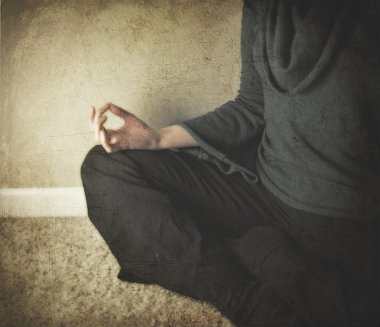In past posts in this series on Meditation for Chronic Pain, we looked at the mechanisms behind meditation’s effectiveness as a component of a comprehensive treatment plan, as well as how to meditate. What’s next?
Well, if you’re ready to incorporate a mindfulness meditation practice into your regular chronic pain treatment program, you’ll want to set up a home meditation practice and develop it into a regular, consistent routine. This post will help you do just that.
Use this handy getting-started guide to create your own home meditation practice, then browse the collected links at the end of this article to explore the world of meditation in all its many lovely forms.
Creating an Environment That Enriches Your Home Meditation Practice Your Surroundings
The best thing you can do to support a regular home meditation practice is to find – or create – the perfect space for it.
While you can meditate just about anywhere (even walking around your neighborhood), using a dedicated space will help you reinforce the habit of meditation – and the more consistently you meditate, the better your results will be in terms of pain management.
Here are some tips to get the different aspects of your meditation environment just right.
Props and Clothing
First and foremost, you should avoid any clothing that is uncomfortable in any way — tight, restrictive, itchy, not warm enough for the environment you’ll be sitting in, or too warm for the environment you’ll be sitting in.
Some suggestions on clothing:
- Loose fitting tops without scratchy tags
- Leggings
- Yoga pants
- Sweatpants
Generally, just keep it comfy, and with no distracting ornamentation or skin-irritating fabrics or threads.
As for props, you might find yourself in need of some assistance to maintain a good meditation position for any length of time and make it more comfortable for you. Bolsters and pillows can help you support aching body parts, while soft, natural-fiber blankets can help keep you warm.
Finally, think carefully about whether you want to add candles and incense. On the plus side, invoking/involving a variety of senses can help improve your meditation experience. But if you’re just going to sit there and be distracted by whether the candle might catch something on fire or whether incense ash is falling on your fine furniture, then skip them.
Distractions
If comfort is the number one rule of a home meditation practice, distractions are the number one no-no. So, when it’s time to meditate for the day, do yourself a favor and …
- Turn off all phones and televisions.
- Let your family/roommates know you’re not to be disturbed (if this isn’t possible, see the next suggestion for some timing suggestions to make sure you won’t be interrupted).
- Put pets outside or in another room.
- Be aware of outside sounds — if you know the road crew is going to start up at 8 AM on the dot, meditate at 7:30 instead. Sounds that we are accustomed to during our normal daily routines can become very distracting during meditation.
Using the Power of Habit to Reinforce Your Daily Meditation Schedule
“All our life, so far as it has definite form, is but a mass of habits.” William James wrote that in 1892 and it’s every bit as true today as it was in his time or hundreds or thousands of years before that.
Habit is a force that, once grooved into our neurological pathways, compels us forward in ways that can be either good, constructive, healthful, beneficial — or bad, destructive, dangerous.
Knowing that fact gives us a super power of sorts, though. By harnessing the power of habit, we can create some pretty incredible changes in our lives with relatively little fuss or drama.
This works well when you’re starting a healthy new habit, such as a regular meditation practice.
The key is consistency, and commitment for the short haul — roughly 21 days. That’s just three weeks you’ll have to power through your new routine – but after that point, your meditation practice becomes a habit.
For more on using habit to create positive change, check out The Power of Habit by Charles Duhigg.
Scheduling and Frequency
For best results, aim to meditate every day, even from the beginning. It’s better to meditate for ten minutes daily than for an hour every few days, when you’re trying to establish a regular practice for chronic pain treatment purposes.
Morning sessions, in my experience, are more beneficial than sessions later in the day. But if the only time you can establish a regular meditation habit is after dinner, or before bedtime, or during your lunch break, then by all means do that.
Aim to meditate at roughly the same time and in the same place every day. This will help you develop the meditation “habit” more easily.
Length of Session
In the beginning, if you don’t have any significant experience with regular meditation, aim for short sessions of ten to fifteen minutes.
Then, as you become more adept at the practice, try to extend your sessions in short increments — say, from fifteen minutes to eighteen minutes.
Finally, don’t commit yourself to long, thirty-minutes-plus sessions in the beginning. Meditation is a skill and like any skill, it takes some practice to become adept at it. It also requires some physical adjustment, as our bodies aren’t used to sitting still and awake for long periods of time.
So go easy on yourself, and set yourself up for success, rather than failure.
Some More Helpful Links on Establishing a Regular Meditation Practice & Mindfulness Meditation in General
In the interest of keeping it non-threatening and non-overwhelming for beginners, I’ve pared down the list of resources offered here to just a handful of recommendations in each category.
Bear in mind, this is but a tiny fraction of what’s available out there — much of it excellent, some of it questionable, and a small percentage possibly even harmful. The resources here are ones I’m personally familiar with, and will definitely get you started. As with any component of your chronic pain treatment plan, exercise your own good judgment, and talk with your doctor about any specific concerns.
From there, follow your interests and ask others (or me) for recommendations!
Websites and Links on Meditation
There are a vast number of resources available on the web that can help you learn how to meditate and expand your meditation practice. Here are just a few that I particularly like or thought might be helpful:
- Meditation Apps for Inner Peace On the Go – Huffington Post
- Yoga Journal’s Meditation Practice Guide – YogaJournal.com
- A Meditation Guide for the Rest of Us – Lifehacker
- ZenCast – ZenCast.org (many resources, including a meditation timer tool)
Books on Mindfulness Meditation
You may find these books useful:
- Mindfulness Meditation for Chronic Pain Relief: Guided Practices for Reclaiming Your Body and Your Life – Jon Kabat-Zinn
- Mindfulness in Plain English – Bhante Gunaratana
- The Mindfulness Solution to Pain: Step-by-Step Techniques for Chronic Pain Management – Jackie Gardner-Nix
- The Miracle of Mindfulness: An Introduction to the Practice of Meditation – Thich Nhat Hanh
Videos & CDs on Mindfulness Meditation
Jon Kabat-Zinn, a leading mindfulness meditation researcher, has produced a few recorded guided meditation series (series 1 here, and series 3 here) that are available on Amazon. Guided meditation recordings can be very useful for beginners who aren’t really sure whether they’re “doing it right” and just as helpful for experienced meditators who want to explore new forms of meditation.
Finally, you might enjoy this short presentation on mindfulness meditation presented by Kabat-Zinn for Google employees.
Photo Credit
: Loving Earth via photopin cc



